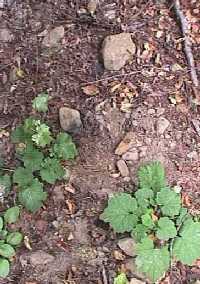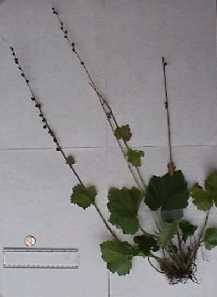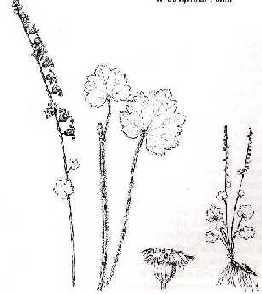


General Species Description
- White fringecup is a rhizomatous perenial herb found in moist coniferous woods and along stream banks. Forming a compact tuft of basal heart-shaped leaves, they have an almost leafless stalk up to 50 cm. Along the stalk are 20 to 30 small, cup shaped green to pinkish flowers.
Leaves
- The dark green leaves are heart-shaped with hairy petioles. They are 10-15cm across and toothed with shallow lobes.
Inflorescence/Flowers
- The 20-30, 5-petalled fowers are borne on one side of the stalk in a raceme. They are greenish-white, aging to pinkish-red and almost 1 cm long. The sepals are fused to form a cup (hence the frequent jar or urn-shaped description) having 10 stamens and greenish white calyx. At the tips, the flowers have many deeply cut, almost hairlike lobes. Blooms May through August.
Fruits
- The dark colored seeds are borne in a one-celled ovary.
Habitat
- Tellima is found in damp, deciduous woods and along stream banks. It is found in association with many herbaceous plants such as Tiarella and Tolmiea but is more of an upland species seen more often in somewhat drier areas.
Range
- It is found from southern Alaska to San Francisco Bay. In Oregon and Washington it is found in all counties west of the Cascades. It is found in eastern British Columbia and Idaho
Similar Species
- Tellima is typical of many of the Saxifrage family having racemes with small whitish flowers above toothed, roundish basal leaves found in damp shady habitats. It is often confused with Tolmiea (the pig-a-back or youth on age plant), and Tiarella (foam cup) and Mitella. (Hitchcock and other authors note that Mitella is an anagram of Tellima. The best way to distinguish these look alikes is with the flowers, dried parts of which remain on the racemes into late summer. The presence of plantlets borne on the axils of older leaves of Tolmiea are definitive but not always present in early stages.
Ecological Value
- Tellima may provide nectar and pollen for insects. No reports of it being used as browse by deer or even insects. The dense root mass may help in stabilizing soils.
Human Value
- No uses by humans are mentioned by the authors cited below. Presumably the delicate flowers provide aesthetic value.
References
- Cooke, S.S., ed. 1997. A Field Guide to the Common Wetland Plants of Western Washington and Northwestern Oregon. Seattle Audubon Society and Washington Native Plant Society. Seattle Audubon Society, Seattle, WA, 417 pp.
Hitchcock, C.L. and A. Cronquist. 1973. Flora of the Pacific Northwest. University of Washington Press, Seattle, WA, 730 pp.
Kozloff, E. N. 1991. Plants & Animals of the Pacific Northwest. University of Washington Press, Seattle, WA. 264 pp.
Mathews, D. 1990. Cascade Olympic Natural History. Raven Editions, Portland Audubon Society, Portland, OR. 625 pp.
This page was created by: Pete Catching, August 2000
Return to Northwest Oregon Wetland Plants Project